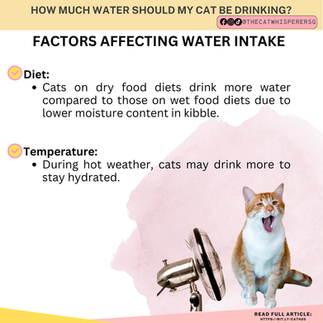How Much Water Should My Cat be Drinking?
- The Cat Whisperer Singapore
- Aug 6, 2024
- 3 min read

Keeping your cat hydrated is crucial for their overall health and well-being.
While cats are known for not being big drinkers, understanding their hydration needs is essential for any responsible pet owner.
Recommended Liquid Intake for Cats
Generally, cats need about 60ml of water per kilogram of body weight daily. For a 4 kg cat, this translates to approximately 240ml of water each day.
This amount includes both the water they drink and the moisture they get from their food.

Cats on a wet food diet may drink less water from their bowl since wet food contains a significant amount of moisture. Always provide fresh water, keep an eye on their drinking habits and consult your vet if you notice any concerning signs.
Factors Affecting Water Intake:
1. Diet:
Cats on a dry food diet will naturally drink more water compared to those on a wet food diet, as dry kibble contains less moisture.
2. Temperature:
In warmer climates or during hot weather like in Singapore, cats may drink more to stay hydrated.
3. Activity Level:
Active cats might require more water to compensate for the fluids lost during physical activity.
4. Age and Health:
Older cats or those with certain health conditions may have different hydration needs.
Steps to Monitor Your Cat’s Water Intake:
1. Measure Daily Intake:
Track how much water your cat drinks daily to spot any significant changes.
2. Observe Behavior:
Take note if your cat frequently visits their water bowl or seems restless and thirsty.
3. Check for Dehydration:
Signs of dehydration include lethargy, dry gums, and skin that doesn't quickly return to place when pinched.
Signs Your Cat is Well-Hydrated:
1. Good skin elasticity:
If you gently pull up the skin on their back and it quickly returns to its place, your cat is likely well-hydrated (skin tenting).

2. Normal Urination:
Cats usually urinate two to three times a day. The litter box should be moist but not overly saturated.
3. Eyes and Gums:
Hydrated cats usually have bright, clear eyes. Moist Gums: Your cat's gums should be moist and not sticky or dry.
4. Alertness and Energy:
Proper hydration contributes to your cat's overall vitality.
Excessive Drinking in Cats:
While staying hydrated is essential, excessive drinking can be a red flag for underlying health issues. If your cat suddenly starts drinking a lot more water than usual, it might be time to consult your vet as it could be an indicator of potential health issues:
1. Diabetes:
One of the most common signs of diabetes in cats is increased thirst and urination. Recommended to do full blood test and fructosamine test (measure the average blood glucose levels over the past two to three weeks).
2. Kidney Disease:
Chronic kidney disease can cause cats to drink and urinate more as their kidneys lose the ability to concentrate urine.
Recommended to do full blood test and SDMA test (early indicator test for kidney disease).
3. Hyperthyroidism:
This condition can also lead to excessive thirst and increased urine output. Recommended to do full blood test and Total T4 (Thyroxine) test (measures the level of thyroxine).
4. Urinary Tract Infections (UTIs):
Cats with UTIs may drink more to alleviate discomfort and flush out their system.
Recommended to do full urinalysis.
The moisture in their food does make up for a good portion of it, so there's no need to be forcing them to drink water unnaturally for no reason. If in doubt, use a calculator: https://tinyurl.com/calculateh20
Downloadable Infographics also available on Instagram: @thecatwhisperersg
Like & Share!



















Overall, the article is an excellent resource for cat owners to understand the importance of hydration, how to monitor their cat’s water intake, and when to seek veterinary care if there are concerns.
visit us <a href="https://jakarta.telkomuniversity.ac.id/en/">click here</a>